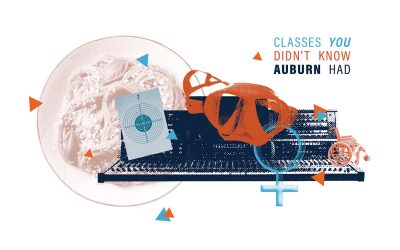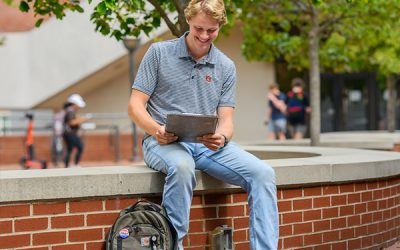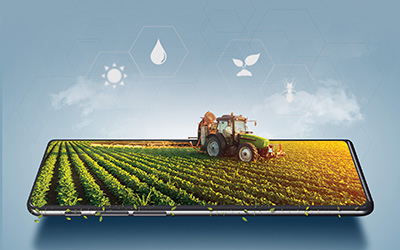To detect modern viruses, Auburn’s Canine Performance Sciences team is using an ancient tool—a dog’s nose
By Derek Herscovici ’14
LONG BEFORE COVID-19, researchers at Auburn University were building a tool to detect invisible or hidden threats at the microscopic level. This mobile detection unit can pinpoint the source of a threat in an area as vast as an airport or football stadium, and can perceive harmful chemicals faster than any current technology.
The secret? A dog’s nose. It’s the focus of research being done by Auburn’s Canine Performance Sciences (CPS) program that could become the future of detecting viruses, bombs, dangerous chemicals and more.
“We think about the dog as a mobile, hyper-sensitive, rapidly programmable chemical and biological detection platform,” said Frank Bartol, associate dean for research at the Scott-Ritchey Center, a cutting-edge research facility within the College of Veterinary Medicine. “The canine’s nose has evolved over eons because dogs see the world through olfaction—their sense of smell.”
The CPS group already achieved international recognition for the creation of “Vapor Wake Dogs” used to monitor massive enclosed spaces like airports for threats around the country.
When the dogs sniff out threats like bombs, they’re actually detecting the unique “odor signature” of the chemicals that are used. Each chemical leaves an odor signature that can stand out like red flags for a properly trained dog. Once the dogs have detected the threat in a given area, resources can be brought in to mitigate or remove it.
In 2019, CPS began researching whether the dogs could detect certain strains of airborne viruses that are otherwise undetectable by humans. Like training the dogs to detect the chemicals in bombs, it is critical that they know which odor signatures to look for and which to ignore.
The problem, Bartol explains, is how to train dogs (and humans) around a potentially deadly substance that sometimes requires only a thimble’s worth to cause disaster. The term they use in training is “taking the ‘boom’ out of the box.” Through Polymer Odor Capture technology, a device the size of a cell phone can “capture” the unique scent of the specified chemical and isolate it in a nonlethal format. The device can then be implemented in a variety of formats—inside a closed lab or hidden inside a large space.
Now, you’ve captured it on some kind of matrix the size of a cellphone, and you can now take this out—it poses no threat to anybody—but it’s got the real smells, if you will, the real odor signature captured, and you can imprint the dog on those odor signatures,” said Bartol.
Though they are working with a type of coronavirus, Bartol emphasized that they are not using SARS CoV-2, the virus that causes COVID-19, because Auburn does not currently have the BioSafety Level 3 labs necessary to handle it safely. However, the dogs have already been able to accurately detect and discriminate Bovine Viral Diarrhea Virus, a virus that is nonlethal to both dogs and humans, and this will lead to promising tests in the future.
“The issue is, can dogs detect biological targets? They always have. It’s built into their DNA. Now, let’s figure out which category of biological stuff they’re good at, and can we refine that and build upon that to help us detect threats and then mitigate those threats.”
That’s a Class? Six Unique Classes You Didn’t Know Auburn Offers
From safely shooting a gun to cooking an excellent meal, these unique and often overlooked classes in Auburn’s curriculum may surprise you.
What Do Students Carry In Their Backpack?
This ever-present functional accessory is more than a carrier of books, it’s also an expression of a student’s personality, lifestyle and even goals.
Artificial Intelligence and Auburn University
The future of machine learning is less about robots becoming sentient and more about helping humanity grow better crops or deliver a hotter latte. Auburn researchers are at the forefront of showing how AI will integrate into our everyday lives, one line of code at a time.
That’s a Class? Six Unique Classes You Didn’t Know Auburn Offers
From safely shooting a gun to cooking an excellent meal, these unique and often overlooked classes in Auburn’s curriculum may surprise you.
What Do Students Carry In Their Backpack?
This ever-present functional accessory is more than a carrier of books, it’s also an expression of a student’s personality, lifestyle and even goals.
Artificial Intelligence and Auburn University
The future of machine learning is less about robots becoming sentient and more about helping humanity grow better crops or deliver a hotter latte. Auburn researchers are at the forefront of showing how AI will integrate into our everyday lives, one line of code at a time.


